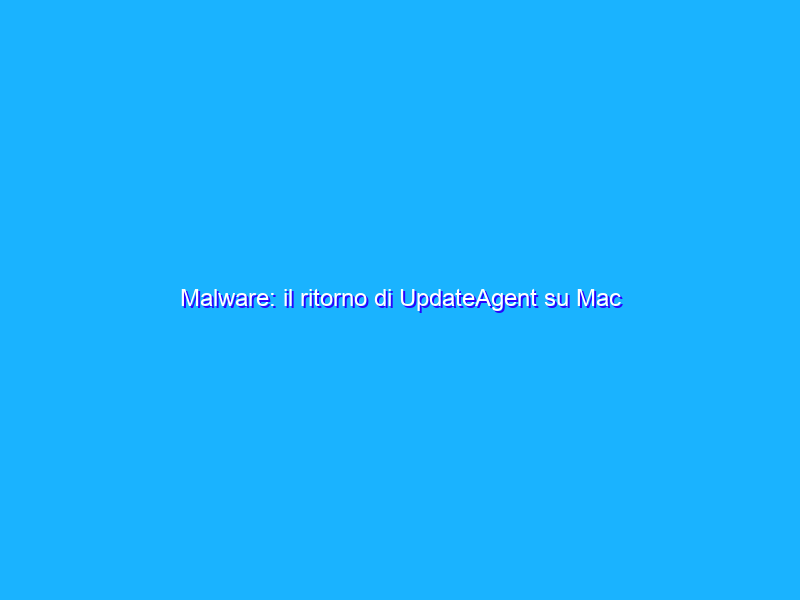Mate Xs 2: ufficiale in Europa il flagship pieghevole di Huawei
Malware: il ritorno di UpdateAgent su Mac
Lunghissimo cavo Ethernet (10Mt) prezzo BOMBA su Amazon
5 Timely Ways B2B Brands Can Conquer Metaverse Marketing


The metaverse — a term coined in a 1992 novel — isn’t done cooking yet, but with a world that needs to eat right now and chefs that need to cook, what do B2B brands need to know to get ready?
Just 18 percent of brand marketing and analytics executives said that they understood the metaverse and how it will affect their brand, according to recently-released survey data.

Despite limited general understanding of just what the metaverse is and may become, the areas that it will encompass are vast, running the gamut from digital currency and assets and natural language processing to device independence and marketplace commerce, as Gartner recently outlined.

Let’s warp right in and explore five ways that B2B brands can succeed with metaverse marketing, and the pitfalls that savvy marketers must watch out for.
1 — Moving Past A Disconnected Hodgepodge
The metaverse is currently a disconnected hodgepodge of holographic hopes and digital dreams that may or may not eventually reach the sustainable velocity to capture the hearts, minds, and wallets of the public and private sectors.
As someone who’s been around online communications for over 38 years now, it’s hard to not see the metaverse as just another “cyberspace / next big thing” and a variation on a theme already played out by virtual reality (VR) and augmented reality (AR), however it’s undeniable that the theoretical promises it holds true could indeed be achievable if the digital stars precisely line up.
Otherwise, the metaverse may face a scenario that marketing cartoonist Tom Fishburne recently summed up in his Marketoonist piece, “The Future of the Metaverse.”

2 — Avoiding The Siloed Platform Trap
A primary danger the metaverse faces is falling into the siloed social media platform trap, with walled gardens of innumerable metaverse-like instances each owned by separate entities and all not being able to — whether on purpose or otherwise — talk to one another, or even willfully trying to prevent people from leaving their particular slice of metaverse pie.
Despite this danger, as we covered in our weekly Friday B2B marketing news, predictions for adoption of the metaverse have shown swift embracing of the technology. 30 percent of global organizations will offer products or services through the metaverse by 2026, while 25 percent of people will utilize at least an hour each day using metaverse technology, and while it won’t be owned by a single vendor, the future metaverse will likely boost engagement even among enterprise users, according to the Gartner report data.
When it comes to what marketers think about the metaverse, one recent survey found that some 55 percent of marketers said that the metaverse will have a positive impact on marketing, with 11 percent seeing it as having a negative effect, while 34 percent remained neutral on the question.

Other survey data has shown that those in younger demographic groups have already begun to spend more time using existing forms of the metaverse. Gen Z consumers interact socially in the metaverse twice as much as in real life, the study showed.
Additional recent survey data showed that 36 percent of U.S. adults said that they were interested in the metaverse, while 56 percent of millennials and 51 percent of Gen Z consumers expressed interested.
[bctt tweet=”“A primary danger the metaverse faces is falling into the siloed social media platform trap, with walled gardens of innumerable metaverse-like instances each owned by separate entities not willing to talk to one another.” — @lanerellis” username=”toprank”]3 — Metaverse Content Is Still King
When new technology such as the metaverse comes along it can be helpful to keep some enduring digital marketing truths in mind, particularly the one our own CEO and co-founder Lee Odden shared years ago, “Content is the reason search began in the first place.”
The metaverse — just like a search engine — is empty without content, in the same way that social media platforms and web properties would be empty wastelands without the digital lifeblood of content.
Great content can be smoothly adjusted and messaged to succeed in virtually any medium or format, so brands that are creating winning content are already poised for doing well in the metaverse.
As the currently chaotic metaverse evolves, brands may face the need to format multiple versions of the content they want to share, each tailored to a specific flavor of metaverse — a solution that while certainly not ideal, gives brands the opportunity to test the waters and compare engagement levels within each metaverse incarnation.
Even with the right content at the right time, if the metaverse doesn’t achieve the cohesion it needs to achieve business buy-in and mainstream acceptance, it runs the risk of being relegated to the “Metaverse Hype Cycle,” at Tom Fishburne examined in another recent Marketoonist cartoon.

Adobe’s 2022 creative trends forecast — from the innovators at its Adobe Stock arm — included the metaverse among its key motion trends for the year ahead, alongside its “otherworldly visions” design trend. We explored this and other top B2B marketing design trends recently in, “Visual Focus: The Digital Designs Propelling B2B Brand Success In 2022.”
[bctt tweet=”“Great content can be smoothly adjusted and messaged to succeed in virtually any medium or format, so brands that are creating winning content are already poised for doing well in the metaverse.” — Lane R. Ellis @lanerellis” username=”toprank”]4 — Hold Tight & Keep Up For A Wild Metaverse Ride
Brands not quite ready to enter one of the nascent available metaverse test-beds can hold tight and keep watch on how the technology plays out, while keeping potential metaverse-friendly content in mind to begin trying out in the format once the time is right.
Brands can assure readiness for their eventual participation in each variety of the metaverse by registering accounts with the current crop of top players in the technology, to reserve the organization’s name in at least a placeholder state.
Global banking giants JPMorgan Chase and HSBC are two of the major firms that have already begun scoping out territory within the metaverse, as Rachelle Akuffo explored recently in “Companies are betting big on real estate in the metaverse.” Akuffo makes mention of “the various metaverses that are being developed,” which points to the disjointed nature of our current metaverse.
Meta — the parent company of Facebook and Instagram — besides choosing a name that evokes the metaverse, has heavily invested efforts in the metaverse, which has led many to assume that “the metaverse” is an extension of Facebook.
It’s also paved the way for advertisers to be a part of its particular implementation of the metaverse, as Sheila Dang recently outlined for Reuters in “Meta inks partnership for 3D ads in step toward the metaverse.” Virtual metaverse classes were also among the initial areas that will be tested within Meta’s Horizon Worlds VR platform, as outlined in an additional recent Reuters report.
5 — Heed History’s Lessons And Sir Tim’s Take
When Sir Tim Berners-Lee invented the Web, as we detailed in “Classic Marketing Insights to Celebrate the Internet’s 50th Birthday,” one of his biggest goals was to make it easier for people to find information on the Internet — an ambition that has undoubtedly seen tremendous success perhaps beyond any other technology in history.
In recent years he’s been involved in Solid, a decentralized open-source data-storage technology developed by Inrupt, a firm he co-founded.
“People ask about virtual reality, and if the metaverse is going to be the whole future, and the answer is that it’s going to be part of the future,” Berners-Lee recently observed in Nate Lanxon’s Bloomberg article, “The World Wide Web’s Creator Wants Metaverse VR.”
[bctt tweet=”“People ask about virtual reality, and if the metaverse is going to be the whole future, and the answer is that it’s going to be part of the future.” — Sir Tim Berners-Lee @timberners_lee” username=”toprank”]“If we do build 3D worlds let’s build them so that I can put a 3D world on my website and you can put one on your website and using VRML we can have a portal so that people can wander around my world and then go through on the open web to join these 3D worlds together without having to go through any one central place,” Berners-Lee recently suggested in Ann-Marie Corvin’s TechInformed article, “Berners-Lee describes his vision for a joined-up metaverse – and it’s decentralised”
“Persuading people to do things a different way is really hard,” Berners-Lee also lamented.
Berners-Lee’s cataclysmic web was significantly helped along by the standards organization known as the World Wide Web Consortium, and a small but growing number of technology experts have expressed hope that similar oversight and guidance can still be applied to the metaverse.
“No single company should ever exert control — it’s simply too important for that to happen,” David Reid, professor of artificial intelligence (AI) and spatial computing at Liverpool Hope University recently shared with Martyn Warwick in a TelecomTV piece, “Self-regulation just won’t cut it in the metaverse – it needs a virtual Interpol.”
Protecting privacy, preventing abuse, ensuring interoperability, and enabling access are the four key issues the metaverse faces, according to Berners-Lee’s World Wide Web Foundation — the non-profit organization he founded in 2009 — as outlined in Kara Dunford’s “The metaverse: a bold, exciting digital future or a digital dystopia like we’ve never seen before?”
“It’s important that the metaverse is built as an open plain rather than a walled garden, with no one company at the helm. There will be no one single metaverse — but rather many metaverses,” Dunford noted. “We need common standards and interoperability to bridge between these spaces, so that we don’t end up with separate digital confines but can instead travel seamlessly between virtual spaces with the same avatars and other digital assets,” Dunford added.
An additional movement seeking to play a role in shaping the future of the metaverse is the Web3 concept, which looks to incorporate elements of blockchain technology, as Cathy Hackl, chief metaverse officer at Futures Intelligence Group recently explored in the Forbes article, “An Evolving Strategy For The Emergent Metaverse: A Web3 Manifesto For Brands And Artists.”
“Web3 is a collective evolution in experiences between brands, artists, and audiences,” Hackl noted, adding that it’s also “an evolving framework that defines a brand’s relationship with this new capability.”
She also sees a Web3-shaped metaverse giving brands, “An opportunity to expand their audience, deepen the connection with their existing audience, or even a way to engage with a completely new audience.”
We’ve featured Hackl several times on the TopRank Marketing blog, including “Augmented Reality: How to Leverage AR in Marketing With Cathy Hackl.”
Tune In To The Metaverse’s Universal Marketing Music
What does this all mean for B2B marketers?
While the metaverse is still at least somewhat in its wild west stage, B2B marketers should keep in mind the developments it’s currently going through that we’ve outlined, and keep up with the changes that it will inevitably see in the near future.
Whether you are just testing the metaverse waters for B2B brands, making the decision to go all-in, or taking a wait-and-see approach will be a choice each brand needs to make, and whichever you choose we hope that the information we’ve explored will help in making an informed decision.
In today’s digital-first landscape, creating award-winning B2B marketing requires considerable time and effort, which is why more firms than ever are choosing to work with a top digital marketing agency such as TopRank Marketing. Contact us to learn how we can help, as we’ve done for over 20 years for businesses ranging from LinkedIn, Dell and 3M to Adobe, Oracle, monday.com and others.
The post 5 Timely Ways B2B Brands Can Conquer Metaverse Marketing appeared first on B2B Marketing Blog – TopRank®.
Phishing: allegati HTML usati per rubare dati
Creating new career opportunities with Google Cloud
A year ago, in a forum with chief technology officers from our Google Cloud Partner network, there was one topic on everybody’s mind: talent. Or more specifically, a lack of it. All the leaders in the room were finding it incredibly difficult to hire, train and retain top cloud talent. I was hosting this forum and so went away to think how we could best solve this challenge and grow the pool of available cloud-skilled individuals.
In my day job, I lead a team of engineers in the U.K. and Ireland who work with our partners’ technical teams to enable and support them in delivering Google Cloud technologies to our customers. So I was motivated to solve this skills gap. This is not unique to us, either: we know from Gartner that through 2022, insufficient cloud Infrastructure as a service skills will delay half of enterprise IT organisations’ migration to the cloud by two years or more. So this is an industry-wide challenge.
We wanted to do something locally, to help grow the pool of available skilled individuals, ideally tapping into underrepresented groups. This was the genesis of Project Katalyst: to create a programme that would provide equal access to job opportunities for young people who may not have had the chance to go university, giving underrepresented groups a path into a rewarding, well-paid and growing tech sector. Yes, it’s Katalyst with a K, not the traditional C; this is a nod to Kubernetes, a key component of the training. In the recent LinuxFoundation 2021 Jobs Report, cloud and container technologies were ranked as the hottest skill.
To do this quickly at a large scale, we needed to work with a partner with experience in this area. We were introduced to Generation UK, a charity which already does exactly what we are looking to achieve. After our first meeting, it was clear we were completely aligned. Over the following months, as we developed the programme with Generation UK, their drive and expertise has been invaluable in creating the ideal way to prepare, place and support people into careers that would otherwise be inaccessible, all on Google Cloud.
Google already does a lot to make the workplace as inclusive as possible. For me, the Katalyst programme helps us to bring part of that inclusivity to our partners and the wider communities we live in. Growing up, I always thought one day I would be a teacher, following in my mother’s footsteps. While I took a different career path, for me it’s fantastic to have the opportunity, through this programme, to enable life-changing careers, supporting others to learn and hopefully enjoy working with Google Cloud as much as I do, fulfilling, in part, a dream I once had.
The Katalyst programme is 12 weeks long, with the initial pilot running this summer 2022, covering both technical and soft skills training. On the course, participants will go through the Google Cloud Digital Leader certification,and will also do much of the training for the Google Cloud Associate Cloud Engineer certification, which they will be expected to complete in the first six months of their new roles, once they start at our Google Cloud Partners.
Participants will then get to meet and interview for confirmed roles at our Google Cloud Partners with an expected annual salary of up to £30,000 in London. To grow the pool of underrepresented people working on our technology and the workplace in general, the programme is aimed at participants representing a balance of genders, ethnic minority communities, young people who are furthest away from the labour market through no fault of their own, individuals who are not in education, employment or training for more than 6 months, or those with a mental or physical challenge, who’ve not had a chance to develop their skills. The hope is to then expand this out to other locations in the U.K. and beyond, as well as our customers’ organisations, after we deliver a successful pilot.
If you would like to offer a place to one of our participants at your organisation, you can learn more here or if you are interested in applying for one of the places, or know someone who might, you can apply on Generation UK’s site
Xiaomi Mi Band 6, Amazon sgancia la BOMBA: solo 34€
Disney+ apre alla pubblicità: ecco i primi dettagli del piano più economico
WhatsApp, come impedire di essere aggiunti ai gruppi?
Calcio: cosa è cambiato in serie A nel corso degli anni
Con il campionato di serie A 2021-2022 sono trascorsi precisamente vent’anni da quando la Roma vinceva il suo terzo scudetto. Un dato che in termini statistici ha un significato importante e speciale, dato che quella fu l’ultima volta che una squadra non appartenente all’asse Torino-Milano vinceva il titolo di campione d’Italia. Dal 2001-2002 fino a quest’anno compreso, lo scudetto è stato assegnato solo a tre squadre: Juventus, Inter e Milan. Naturalmente la parte più importante è toccata alla Juventus con undici titoli, a seguire l’Inter con sei successi e il Milan con tre vittorie. Un dato statistico che è la cartina tornasole rispetto a quello a cui abbiamo assistito in questi anni.
Un dominio delle squadre del Nord, come del resto è sempre stato, ma senza alcuna sosta, nonostante Roma, Napoli e Lazio abbiano tentato più volte di conquistare il tricolore. Quest’anno il Napoli di Luciano Spalletti ha occupato per lungo tempo i piani alti della classifica, ma dopo la seconda metà del girone d’andata sono emerse Milan e Inter come squadre più forti del torneo. Un duello che è durato fino all’ultima giornata e che per certi versi ha dato la sensazione nostalgica di come venivano disputati i tornei più di 30 anni fa, quando la proclamazione della squadra campione d’Italia arrivava proprio nelle ultime giornate, dato che le formazioni si davano battaglia fino alla fine. In particolare questo si verificò proprio l’anno del secondo scudetto del Napoli, nel 1990, quando alla penultima giornata il Verona batteva il Milan di Sacchi mentre Maradona e compagni espugnavano il Dall’Ara di Bologna.
Al Napoli bastava un pareggio interno contro la Lazio, ma arrivò la vittoria grazie a una rete realizzata da Marco Baroni, oggi tecnico del Lecce. In una certa misura però il campionato di serie A e la sua competitività ha riacceso un’attenzione che mancava da tempo, non solo per merito di Milan, Inter, Napoli e Juventus, le prime quattro forze del campionato, ma anche grazie alle squadre di media e bassa classifica. Non capiva spesso infatti che una big del torneo venga fermata, addirittura in casa da chi sta lottando per non retrocedere. Quest’anno abbiamo assistito a uno spettacolo diverso che è indice di un ritrovato equilibrio tra le parti, dove anche le neopromosse, vedi lo Spezia, ma in generale ogni squadra può incidere sulla stagione con i tre punti a disposizione. Un aspetto che di fatto ha reso più coinvolgente e appassionante anche il discorso legato al betting, alle scommesse sportive.
Ogni gara, specialmente nel corso del girone di ritorno, ha avuto un significato e non era così scontato il risultato finale, visto che questa cosa è successa anche in partite come Empoli-Napoli, Genoa-Juventus e Roma-Venezia, con il Venezia già retrocesso che blocca la Roma di Mourinho in corsa per un piazzamento valido in Europa. Naturalmente i pronostici di queste partite erano a favore delle tre big coinvolte, con un risultato sorprendente che ha dato gioia a chi invece ha piazzato la scommessa sulla formazione data come sfavorita. Stava già accadendo da qualche tempo che una squadra di livello medio creasse grandi problemi a chi invece lottava per la Champions League o addirittura per il titolo.
Molti ricorderanno ad esempio le battute d’arresto del Napoli di Sarri contro il Chievo e contro una all’epoca modesta Fiorentina. Tuttavia quest’anno il divario tra il Milan e la Salernitana è apparso meno evidente, rispetto alle stagioni passate. Un segnale che qualcosa sta cambiando e che stiamo nuovamente assistendo a un campionato di serie A equilibrato e coeso, come non avveniva da qualche tempo. Ne trae sicuramente vantaggio lo spettacolo, il coefficiente di difficoltà e la capacità ridotta di indovinare una scommessa e un pronostico sportivo.
Fostering inclusive spaces through Disability Alliance
I was 2 when my parents discovered I had polio, which impacted my ability to stand and walk. Growing up in China, I still remember the challenges I faced when I wanted to go to college. Back then, all potential candidates had to pass a physical test, which posed a challenge. Knowing this, my parents, my teachers and even the local government advocated for me. Thanks to their support, I was granted an exception to attend college, where I graduated with a degree in computer science.
When I joined Google in Shanghai in 2011, the real estate team was working to open a new office space. I was part of the planning process to ensure we designed an inclusive workspace, especially for individuals with physical disabilities. When I discovered the desks at the office were too high, or if the meeting space was not designed wide enough for someone in a wheelchair to enter, I worked with the team to solve the problem. I also suggested building wheelchair-accessible restrooms when they were not available on the floor I was working on.
These experiences showed me everyone has the voice to drive change — including myself. I decided to co-lead our Disability Alliance (DA), one of Google’s resource groups in China, with other passionate Googlers. We wanted to create a space to help address challenges Googlers with disabilities face, and build allyship among the wider Google community. We also wanted to create a platform to increase awareness of different forms of disabilities. For example, some people don’t think about invisible disabilities, but it’s equally important to build awareness of disabilities you might not immediately see. I’m incredibly excited to see how we continue to grow our community in the coming year across China.
Having a disability doesn’t limit me, and I’ve been fortunate to be surrounded by people who value my abilities instead of my disability. Over the years, I’ve achieved my goals and dreams from leading an incredible team of 50 at Google, taking on physical activities such as skiing and marathons, and driving change for the broader disability community.

I was ready to compete in a marathon in China back in 2021
As we commemorate Global Accessibility Awareness Day, I also spoke to Sakiko, a fellow member of our Disability Alliance chapter in Japan, to learn more about what drives her, and why it’s important that we provide equal opportunities for all.
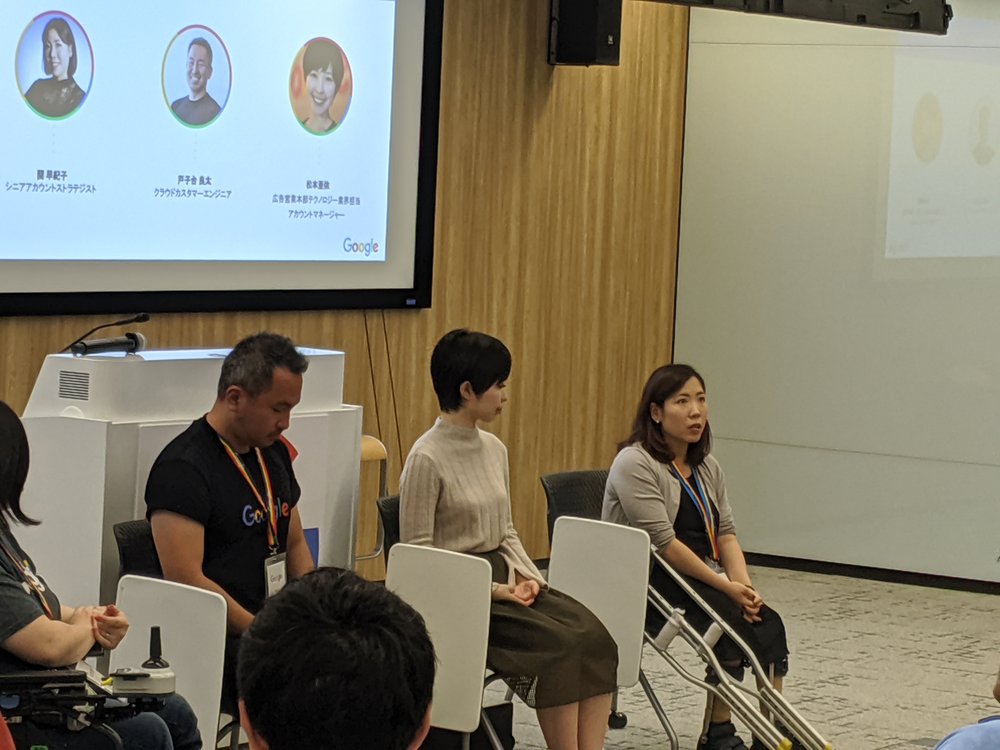
Sharing my personal experience at an external event. I’m seated at the extreme right in a gray sweater.
Tell us more about yourself. What keeps you going at Google after more than nine years?
I was born with spina bifida, and I move around with crutches. I’ve always wanted to work in sales, but when I was job hunting, I was turned down by several companies because of my disabilities. I knew I had the ability and knowledge to sell, and I enjoy interacting with people, so I didn’t give up. When I interviewed at Google, the interviewers focused on my potential and abilities, and not my disability. That surprised me, because I’ve never experienced that. I recalled asking one of my interviewers if my disability would impede this opportunity, but he said, “if you have the ability to sell, it shouldn’t stop you from doing that.” It was amazing and encouraging to hear that. I currently work in the Google Ads team and have experienced various roles. When my clients shared how grateful and thankful they are for my dedicated support, that really keeps me going.
What is a memorable experience you’ve had with the Disability Alliance?
I once hosted a workshop where we invited students with disabilities to have hands-on experience coding their own web application, giving them the confidence to pursue their interest in engineering. At the end of the event, several parents shared that they didn’t know their children had the potential to code and create applications all by themselves. I still remember this day vividly, because it demonstrates everyone has the chance to shine when they are given the right opportunities to learn and develop new skills.
Propongo un nuovo hashtag: #checcevoismo
Oggi mi è stato segnalato un tweet di Carlo Calenda che proponeva, per l’ennesima volta, l’obbligo di identificarsi presso i social network: “Unica soluzione l’obbligo di registrarsi con identità verificata! Basta ragazzini di 10 anni che si espongono, profili falsi/anonimi che insultano. La libertà è responsabilità. A questo ho dedicato un capitolo nel mio libro “la libertà che non libera” [link al suddetto libro su Amazon]”.
Ho provato pacatamente a rispiegare quali sono i problemi di questa proposta, ed è iniziata la fiera dei commentatori che pensavano di risolvere con un tweet problemi che hanno messo in crisi gli esperti e le menti migliori del settore. Per cui propongo di adottare un hashtag che riassuma concisamente questo comportamento: #checcevoismo.
Checcevoismo, s.m. Atteggiamento delle persone che credono che il lavoro altamente professionale e sofisticato di qualcun altro sia facile e che sarebbero in grado di farlo anche loro e pure meglio. Etim. Romanesco “che ce vo’”, “che ci vuole”, sarcasmo usato per affermare che un dato compito è ritenuto facile.
Credo di averlo coniato io l’anno scorso; non ne trovo altri usi precedenti online, ma potrei sbagliarmi.
Mental health resources you can count on
When you or someone you care for is going through a mental health situation, it can feel isolating, overwhelming and distressing. To get through those moments, access to the right resources can make all the difference.
Anxiety and depression increased by 25% across the globe during the first year of the COVID-19 pandemic, and hospitals and doctor groups recently called mental health a national emergency for adolescents. With these issues on the rise, searches for “mental health therapist” and “mental health help” reached record highs this year in the U.S.
Against the backdrop of the global pandemic, geopolitical crises and economic concerns also hit home for many Americans. To help support mental health challenges stemming from these issues, our goal is to surface authoritative information you can trust, create access to helpful resources you need in the moment and show empathy for everyone facing mental health issues. So in recognition of Mental Health Awareness Month in the U.S., here are tools built to support you when you need it most.
Resources for those in crisis
We know that many people turn to Search to get actionable information during a personal crisis, whether it’s related to suicide, sexual assault, substance abuse or domestic violence. In the coming weeks, we’ll update Search to use our AI model MUM to automatically and more accurately detect personal crisis searches in order to show you the most relevant information when you need it.
We’ve also made it easier to access clinically-validated mental health self-assessments from Search for conditions such as depression, anxiety, postpartum depression and post-traumatic stress disorder (PTSD). These self-assessments, frequently used by medical professionals, are meant to help people understand how their self-reported symptoms might map to known mental health conditions.
On YouTube, updates to our crisis response panels better connect you with timely and important resources. For years, YouTube has shown crisis resource panels on certain search queries to connect people with local organizations that can help them through a moment of critical need. Now, crisis resource panels appear on the Watch Page and in search results. The number of topics that display crisis resources in YouTube search results has also expanded to include issues like depression, sexual assault and substance abuse.
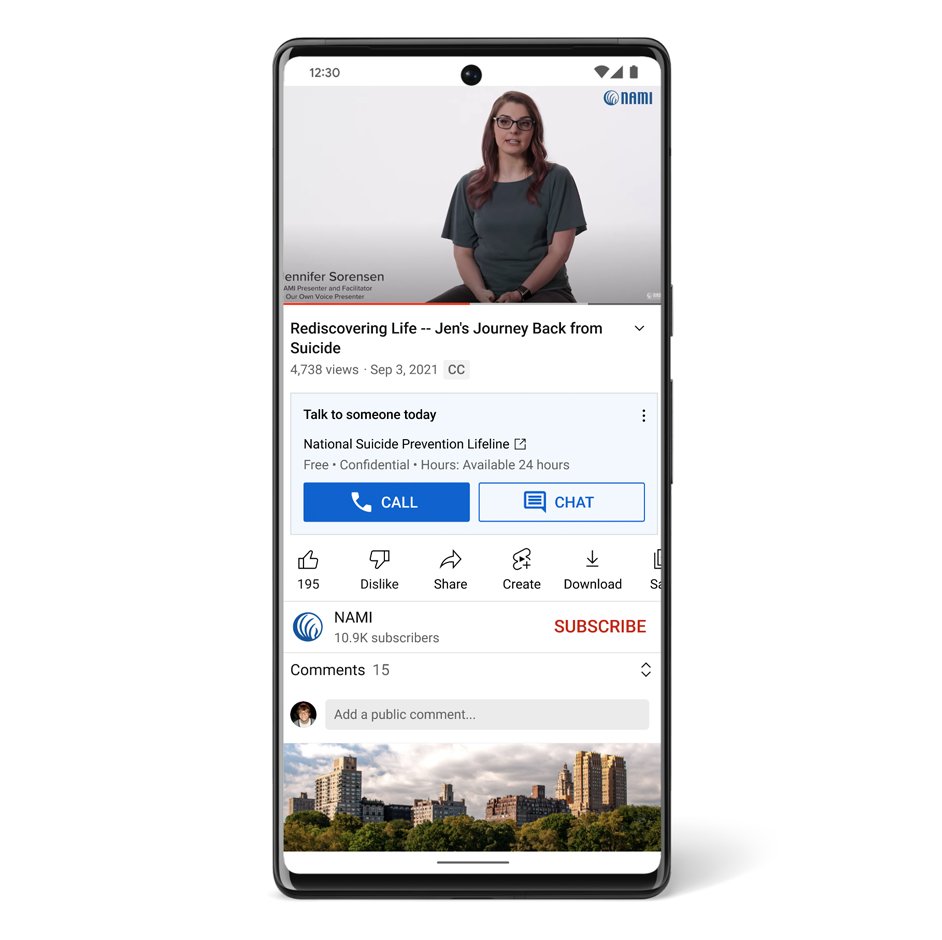
In the past month, searches for “local drug rehab centers near me” reached an all-time high in the U.S. As part of our ongoing commitment to help people find useful and accurate information related to addiction and recovery and to support the newly instituted Fentanyl Awareness Day, our Recover Together resource has a new section. Here you can find more information about the prevalence of fentanyl in illegally-made pills and the importance of naloxone, a legal drug that can reverse overdose from opioids like fentanyl, heroin, morphine and oxycodone.

Building empathy and reducing stigma
Sharing stories about mental health can normalize the issue and reduce stigmas that deter people from getting help. Working with the National Alliance on Mental Illness, YouTube created a guide for creators with tips on how to speak from personal experience, work with experts and use inclusive language.
To listen to supportive community stories and helpful information on mental health, you can watch videos in this playlist on YouTube. For younger audiences, the YouTube Kids app features mental health content on expressing emotions and building coping skills through music, art and more. For more on what YouTube is doing when it comes to mental health, check out this blog.
Personal moments of managing stress
In moments when you need a hand managing your stress levels, Fitbit can help. SelectFitbit devices include a Relax app for deep breathing or an EDA (electrodermal activity) sensor so you can better understand how your body responds to stress — which is especially important as we all cope with the stress of the pandemic. From there, you can take steps to adjust your activity levels, improve your sleep or practice mindfulness to help manage the impact on your wellbeing.
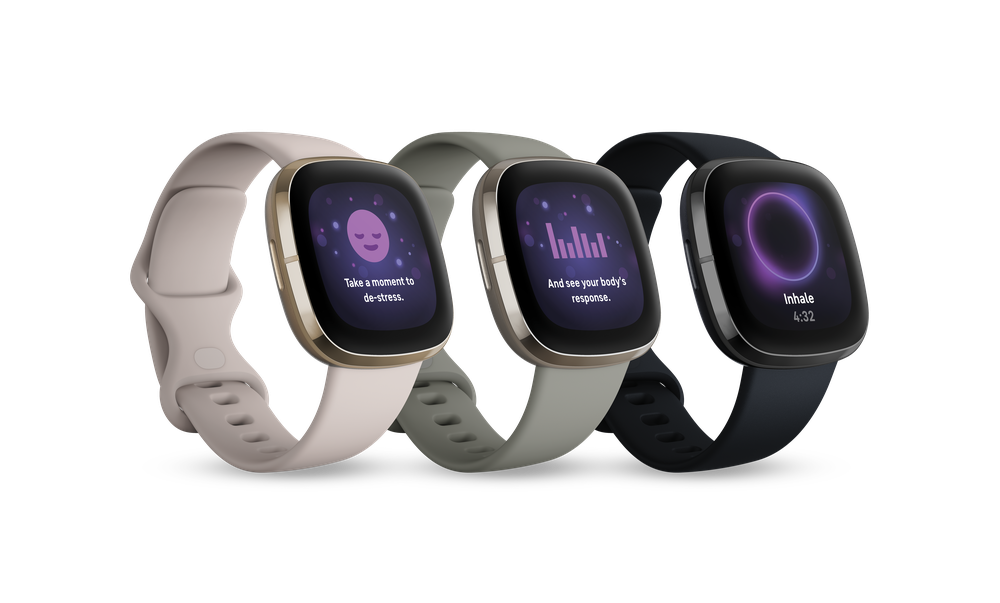
Over the past year in the U.S., searches for “5 minute meditation for anxiety” more than doubled. Using Google Assistant, you can find and play meditations from Calm on your Google Nest display to help relax during the day or fall asleep at night. Just say, “Hey Google, show me meditations from Calm” or “Hey Google, start a meditation.”
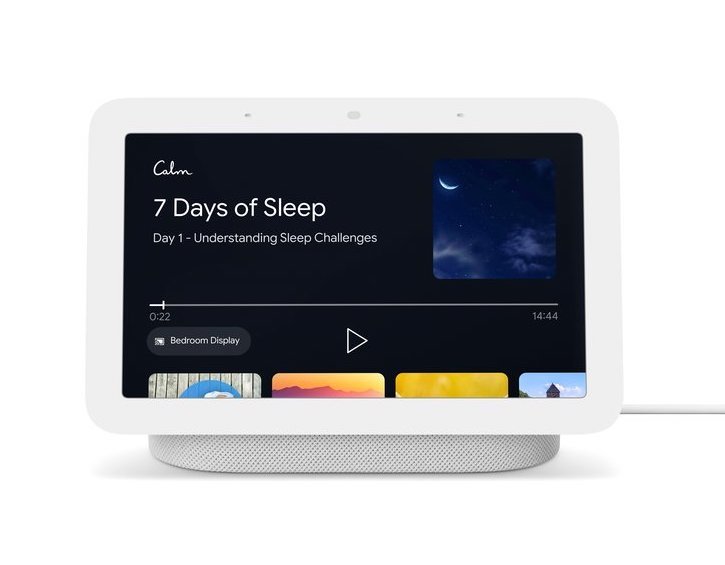
Contributing to community wellbeing
Beyond providing resources to people using our products, we’re also helping organizations and researchers that contribute to mental health.
Since 2019, we’ve provided $2.7 million and nearly 30 Google.org Fellows to help The Trevor Project use AI to support LGBTQ+ youth in crisis. Most recently, Trevor and a team of Fellows built the AI-powered Crisis Contact Simulator (CCS) that lets volunteer trainees practice realistic conversations with digital youth personas. The Trevor Project recently introduced a new persona to expand their counselor training.
Ask for help when you need it
It is always okay to ask for help — whether that’s going to Google or YouTube with questions you’re not comfortable asking anyone else or opening up to your friends and family or connecting with experts who can help you through the difficult moments. We need to support each other however we can.
This Googler hopes his team is one day obsolete
I first met Keawe Block a few years ago, and something he said has stuck with me ever since: “In an ideal world, my team wouldn’t exist.” Keawe, who works remotely in Washington state, is the head of all diversity tech recruiting efforts across North America — his team is dedicated to building a more equitable and representative Google.
His team has made major strides over the years, but we know there’s always more to be done. I recently had the chance to catch up with Keawe to learn more about his team’s approach to finding talent and creating community, every day and especially this May — Asian Pacific American Heritage Month.
How did your team start?
Our team started around 10 years ago out of a desire to put an emphasis on building a more representative pipeline for Google. It came out of a need. We didn’t look like the communities that use these products. Our team works to challenge bias within our interview process, to influence systems and process changes to increase equity, and to advocate for candidates that come from historically underrepresented groups
Why motivates you to show up every day?
This work is more than a passion for me — it’s personal. My motivation consists of two parts: First is leading and developing my team by helping them grow and expand their impact, and second is effectively changing the landscape of Google and tech by building a more representative workforce.
These both have immediate and long-term effects. Google has helped create a life for myself and my family that I didn’t think was possible. If I can use my platform to walk others through that path, that’s a win that can potentially have generational impact.
What would you like to see your team work on next?
Over the years the emphasis on diversity, equity and inclusion have expanded across Google and become a part of everyone’s job. More specifically, every recruiter plays a part in building inclusive pipelines and making Google more representative. We intend to educate and share what we’ve learned to the point where our work is no longer needed, because it is embedded in everything everyone does.

